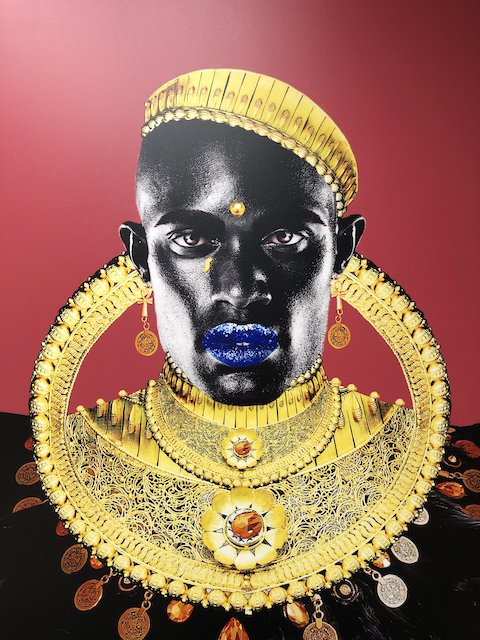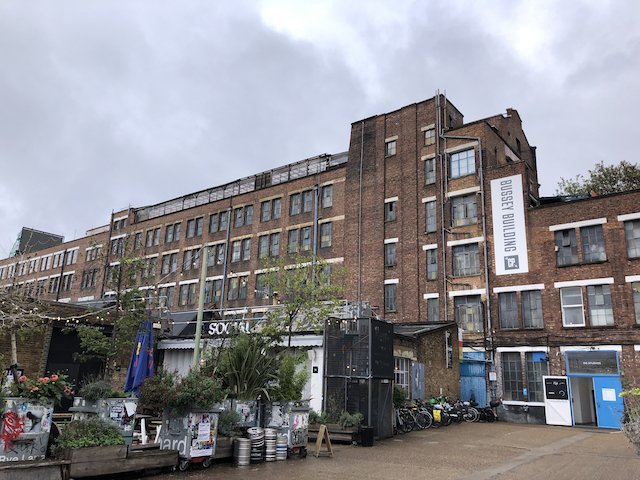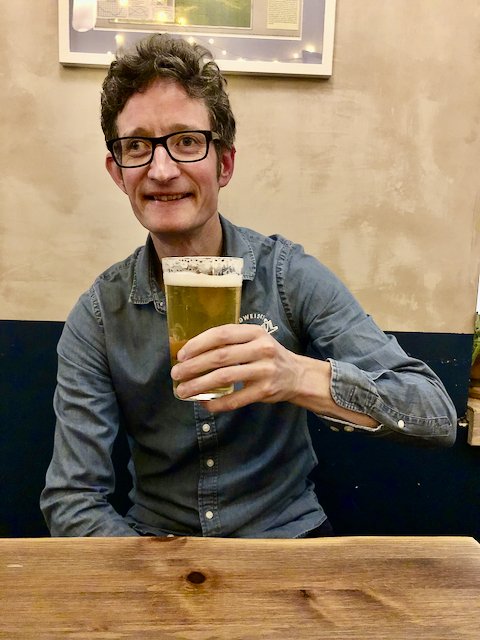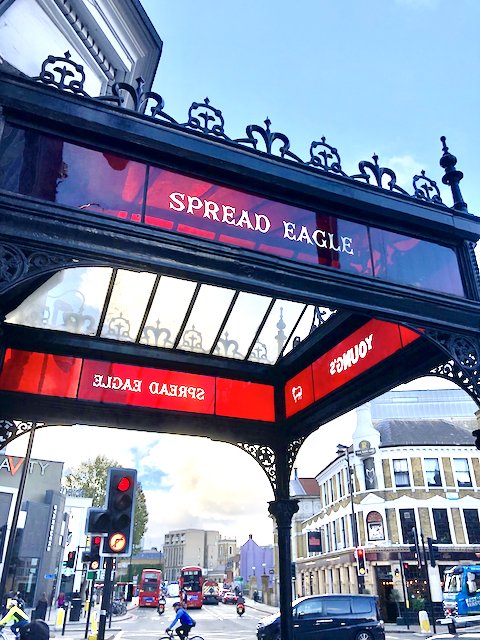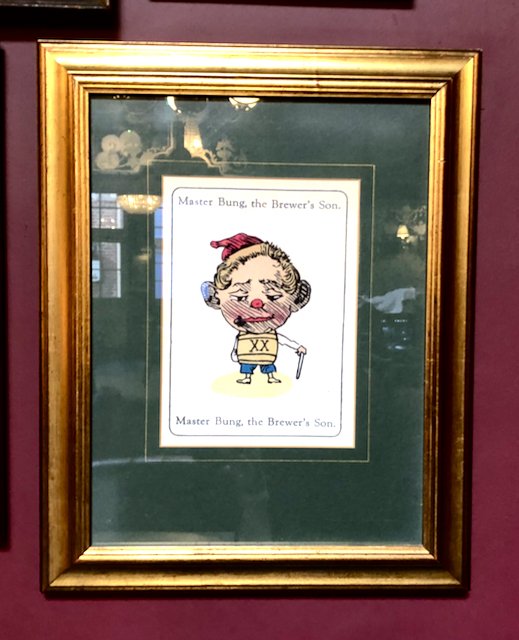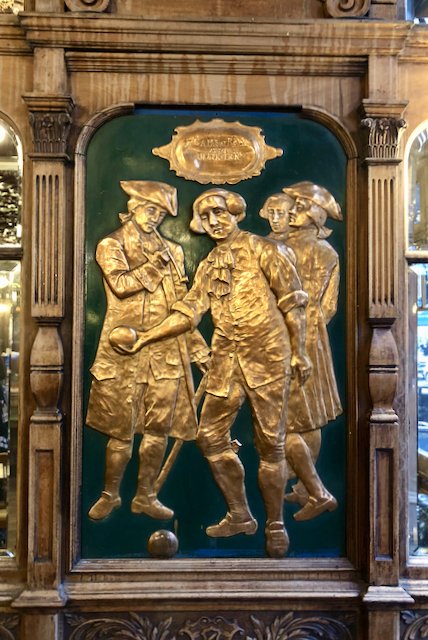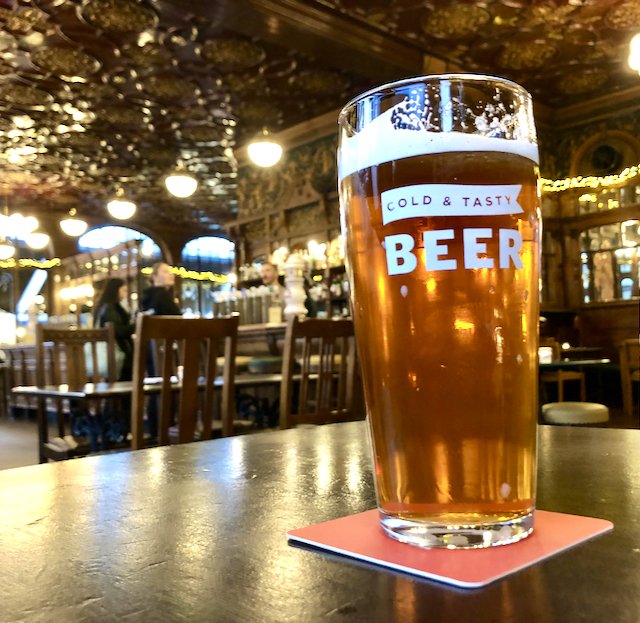November: Peckham's Game-Changing Brewery, Well-Preserved Pubs & Craft Comedy
Enjoy London Beer City? Support it here
Eko Park
Anthony Adedipe is worried about the weather. It’s a Thursday afternoon in early November and rain is rattling down on the roof at Unit 2A-2, Copeland Park, Peckham, Eko Brewery’s new home and bar. Anthony says he’s been chatting to other traders on the estate, and afternoon rain, they tell him, is very bad for evening trade. “I hope it stops,” he says, more in hope than expectation.
Luckily for Anthony and wife Helena, who run Eko together, there are compelling reasons to visit, rain or no rain. Opened last month, this brewery/taproom, the result of five years of hard work, is something new and exciting in a London beer market where an increase in quality has gone hand in hand with a growing saminess.
Eko bucks the trend by drawing on African drinking culture and brewing techniques and recipes, plus ingredients such as palm sugar, cassava, yam and hops grown in South Africa. “The main focus is to incorporate African ingredients in the beer,” says Anthony, “but the first beer we made [in 2018] didn’t have any African ingredients - but it was low bitterness, low carbonation, to ensure it went well with food, which is the way beer is enjoyed in Africa.”
Anthony grew up in Peckham and his family comes from Nigeria (Eko is the Yoruba name for Lagos), while Helena’s are from Congo. That’s had a big impact on her approach to beer. “In Congo, women drink a lot of beer,” she says. “My mum, my aunties drank beer when I was growing up. A lot of the women in my family drank beer more than the men.”
The road to Eko began in earnest in Philadelphia, in 2013. Anthony, an engineer, spent a year working there and Helena visited frequently. He’d first caught the beer bug whilst travelling in Japan, but it was the then buoyant US craft-beer scene that really got them hooked: a craft-beer bar on every corner, as Anthony puts it, beer gardens full of people from all walks of life, a huge variety of flavours and styles. They started home-brewing when Anthony came back, serving it to family and friends, visiting festivals, getting gradually drawn further into the world of craft beer.
In 2018 Eko was launched, growing gradually on the back of two beers: Black, a smoked porter, and Gold, a lager made with palm sugar. They were ready for the next step, but then Covid-19 intervened in early 2020. “We’d just signed a contract for a really large batch of two different beers,” says Helena. “We were looking to be in bottle shops and bars, and some of our biggest customers were restaurants, which had to close. It was a big blow.”
It was touch and go as to whether the brewery would survive, but they fought on, growing their online presence (this is how I tried Eko for the first time: a deliciously crisp Pils, also made with palm sugar). The next challenge was finding a home. “We had people coming from all over wanting to try our beers, but we weren’t always in all of the bottle shops [due to the sporadic nature of] contract brewing,” says Helena. “To grow our customer base we knew we needed to have a permanent home.”
And so here they are, in an energetic corner of an energetic neighbourhood in sunny South London. Modern Peckham has two reputations: ‘little Lagos’ or hipster central, which may seem like different worlds but which come together, after a fashion, here in Copeland Park.
“Finding a site in Peckham is like coming home for me, even though I left when I was a teenager,” says Anthony, who’s 41. “It’s very different from when I used to live here, but it’s still Peckham, right? We feel at home here.”
Eko’s approach stretches beyond beer, taking in music (expect to hear Afrobeat and African jazz at the taproom), art (the walls are currently covered with work by Nigerian-born, London-based artist Caroline Chinakwe) and food with African roots, served from the cabin opposite the taproom. “The idea is, as with the beer, to try to infuse as much of our culture as possible,” says Helena. “In Africa, when you go drinking, it’s a whole experience [in terms of beer and food], you eat a meal. It’s almost unheard of not to eat. There’s always a dish.”
When we spoke, it was Eko’s second week on their new site. Had they yet gleaned any insight into their potential customer base, and whether it might be different from the craft-beer standard?
“It’s mixed, but the majority is, as you say, middle-aged white men,” says Helena [Note: I used that term in the question]. “The craft-beer scene says that it wants to be diverse and open, but often when we used to go to festivals we were the only black people there - and as a woman, I was in a minority too.
“We’re hoping to attract people who aren’t typical craft beer drinkers. When I was a student, I used to go to the Knights Templar, but I didn’t go to many other pubs, not because I didn’t think I would be welcome, but because I didn’t think I would have anything in common with anybody else there. We find a lot of people who don’t fit the craft-beer stereotype are a bit surprised they like it - ‘oh, I didn’t think this would be for me.”
With a new venue and a young family, Anthony and Helena have plenty on their plate - including installing their brewkit, which is not yet onsite. First things first. “We want to get really well established here, to get embedded in the community here,” says Anthony. “We’ll develop a strong local base and go from there.”
………………………
Sponsor London Beer City
London Beer City’s four-figure subscriber base grows every month. Would you like to reach this very engaged audience? I’m looking for a sponsor. Get in touch at londonbeercity@gmail.com
………………………
Do Brewers Dream of Electric Lager?
Jack Hobday, half of the team behind London Black sensations Anspach and Hobday, let slip that he dreams about lager when I interviewed him on the phone recently. “In the dream, I was waiting for a batch to be ready,” he told me.
Intriguing. Want to find out more? You can ask the man himself at the brewery’s Bermondsey stronghold, the Arch House, before their Christmas Carol concert on Friday 1 December. Doors open at 3pm, carols begin at 7. The brewery’s annual Christmas beer - Pfeffernüsse Stout - and a new, festive-spiced Pale Ale (A Christmas Pale) will be offer alongside the rest of the A&H range.
………………………
Crafty Comic
Many of us, I suspect, have felt inspired by Budvar at some point - even if that only extended to the desire for another glass of southern Bohemia’s smoothest Světlý.
Brockley-based stand-up James Dowdeswell, though, is cut from different, more comic cloth. When he witnessed Budvar man Radim Zvanovec cracking wise during a beer-and-cheese talk a few years’ back, he thought - I can do that. And so he did.
Now it’s your chance to find out if it was all worth it. Next Thursday, Dowdeswell brings his ‘Beers of a Clown’ show to the Enid Street Tavern in Bermondsey, having already reduced a full house to helpless mirth at Brew York in, yes, York. If Dowdeswell can bring a crowd of Tykes to a tittering frenzy, south London should be no problem whatsoever.
“You do not need to be into craft beer to enjoy it,” the 49-year-old insisted when I met him recently at SE4’s Joyce. “It’s a subject that I’m passionate about, and I think that comes across in the show. When I first started planning it, it was jokes about beer, but now it’s about my journey in beer, from growing up in a pub in the West Country to the adventure of learning to brew.”
That process of learning led to a beer called Lazy Eye-PA, an English IPA, which is currently in its second iteration, with Olicana - Blighty’s answer to the passionfruit- and mango-heavy hops of America’s Pacific Northwest - playing the starring role. I had a can last week and it tasted great.
The pub he grew up in was The Anchor Inn in Oldbury-on-Severn, not far from Bristol. It serves draught Bass, still a local favourite and Dowdeswell’s first beer at the age of 18. Dad Mike, landlord of the Anchor and a drinks legend in his own right, is, says James, his “drinking partner”. James has been doing stand-up for 25 years, appearing on everything from Extras - check out his turn as Count Fuckula here - to Russell Howard’s Good News.
What next for the man they’re calling “The UK’s leading craft beer comedian”? He admits that his sights are set on a tour of Britain’s village halls, with Lazy Eye-PA served to thirsty punters whilst they lap up his ale-related repartee. After that, his ambition is for Lazy Eye-PA to be the official beer supplier for his beloved Aston Villa - and, once he’s achieved that, he fancies a tour of outer Space. He’s heading for the Stars! Better Czech him out while you still can.
………………………
‘Full Czech Soak’
Speaking of Czechs … amongst other things, they are very good at ensuring their glasses are in perfect condition for serving beer. Next year you’ll be able to see just how good, courtesy of the new London Bridge Tap. Feast your eyes on it here.
………………………
IP Wahey
40ft’s IPA was last week named the best cask beer in London and the South East at SIBA’s independent beer awards. Windsor & Eton’s Father Thames was second.
………………………
New Brews
Did you know that the London Brewers Alliance records new beer releases by London breweries? It does, although some of them (London Pride?!) are not so new. See here.
………………………
Twenty’s Plenty
Parched, the South London pub group, will be celebrating its 20th birthday this month with a series of events across its six-pub estate. Starting with the Roebuck in Borough in November 2003, the four-man team (Isaac Tooby, Michael Robinson, Neil Watson and Shane Ranasinghe, pictured below) has taken on a series of boozers, many of them on the brink of closure. The most recent was The Earl of Derby in New Cross, following The White Horse in Peckham, The Railway in Streatham, Grove House Tavern in Camberwell, The Montpelier in Peckham and The Roebuck.
Their pubs tend to be elegantly decorated, welcoming places with gastro-quality grub; in terms of beer they’ve gradually improved over the years. For more information on events to celebrate their birthday, check out each pub’s social media: here’s what’s happening at the White Horse.
………………………
Devon Knows How They Make It So Creamy
This year’s most hotly anticipated new/revived pub has opened in Soho. The Devonshire is the brainchild of former Guinea Grill head man Oisin Rogers and Charlie Carroll, the founder of Flat Iron. By the looks of the pub’s Instagram account, it has the potential to be a real game-changer in Soho, with the onus on quality - and that should apply to beer as much as anything else. (Look, for example, at this Guinness font).
………………………
Oh Pig Ale
Pig’s Ear, the CAMRA festival run by the East London and City branch, returns for its 39th year between Tuesday 28th November and Saturday 3rd December, at the Round Chapel, 1d Glenarm Road, E5 0LY. This year’s iteration is called Dark Side of the Pig (not sure why).
………………………
Hill to Climb
Gipsy Hill has launched a crowdfunder to help it become carbon negative. They aim to do this by mid-2025, by “decarbonising our production, re-using waste materials, switching raw materials to regeneratively grown products, and electrifying everything else.” More information can be found here.
………………………
Bulls High
Rained a lot recently, hasn’t it? This was the Bull’s Head in Chiswick at the end of October.
………………………
Two Pubs, One City
Black Lion, Kilburn & Spread Eagle, Wandsworth
There are cities - Florence, Buenos Aires, Swanley - where just one visit can change the course of a life. Something about the ambiance of these places is so deeply affecting that it makes you reassess what you once felt obvious, and helps define how you see the world from that moment on.
This is how I feel about Arras, a town in northern France. Fans of the First World War will know it as the site of a battle in 1917 (Vimy Ridge, where a towering tribute to the noble Canucks who fought there looms over the countryside, is nearby), but my initial impressions of Arras came courtesy of a journalistic jolly while I was in the employ of the Kentish Times, more than 20 years ago.
It was a trip defined by gluttony (Lucullus de Valenciennes), art (Watteau, his passion for napes) and WW1, but for me the key aspect was Arras’s marvellous Grand’ Place. It’s huge and solemn, with 155 elegant Flemish-Baroque townhouses around its edge - breathtaking, sans doute, but what really impressed was the fact that it had been rebuilt exactly as it had been after being largely destroyed during World War One.
I didn’t, at that time, know that you could do that. I sort of assumed that architectural progress was inevitable, if often disappointing (I grew up near Ashford, where most structures are a blight on the landscape). The idea that you could just rebuild everything as it was before seemed so refreshing, and so healthy. I don’t dislike all modern architecture - by no means! - but in most instances I can see the value of restoration over revolution.
This fogeyish notion has stuck with me, particularly when it comes to pubs. They thrive on continuity, a sense of inherited conviviality, helping to create that most crucial element, atmosphere - but they’re been subjected to perpetual change over the last half-century. In most instances, they would have been much better served staying as they were.
Which brings me to CAMRA. It does many things these days - too many? - but one that I really like are its Pub Design Awards, and in particular the Historic England Conservation Award, which - as the name suggests - rewards those places which have been kept much as they originally were, but polished up. This year the winner and runner-up were both London pubs, which seemed to me as good an excuse as any to visit them.
Which is how I found myself at The Spread Eagle in Wandsworth on a Friday afternoon, suddenly aware that I’d been here before, after an event at the former Young's (now Sambrook’s) Brewery across the road. As pubs go, this remnant of the great Gin Palace era, built in 1898, is hard to forget. There’s an iron and glass canopy outside the entrance, spelling out ‘Spread Eagle’ and ‘Young’s’. Inside it’s a glistening festival of glass, much of it etched: the panels behind the bar, the magnificent partitions that divine the pub’s huge floor area into three, multitudinous light shades.
What isn’t glass is dark wood, or burgundy-painted wall covered with Victoriana, from a poster depicting a leering beardy chap guzzling beer while riding a fearsome whale - the three elements making up the shape of Great Britain - to ‘Master Bung, The Brewer’s Son’, who looks very sorry for himself. A Victorian poverty map of Wandsworth is a bit close to the bone.
I settle in the far corner with a pint of (over-chilled) Winter Warmer (£6). It’s about 2pm on a Friday afternoon and it isn’t very busy, but the pub still has atmosphere to spare. At the bar two old-timers are nursing pints of Young’s, while a young Geordie is involved in a competition with the barlady to see who can be nicest. “I’ll just pop these here, shall I?” he asks, waving paper menus towards a wooden menu holder. “Yes please darling, thanks ever so”, “Happy to help”, and so on.
Not everything is quite right - there are too many sofas (the sinking kind that leave you reaching up for your pint from the table), the music is bland, lots of tables are set for dining - but it’s definitely worth a detour, as they say.
The Black Lion in Kilburn, 45 minutes’ north by bus and ginger line, has only one major drawback: it doesn’t open until 4pm in the week, even on Friday. Consequently I’m there right on time - well, a bit early. Even then, a pair of young women beat me through the curtained main door to the bar. They dither when they arrive, though, and I’m able to order the first drink (#pubsmarts).
It’s a pint of Five Points Best and, for the first time in my life, I’m asked if I’m a CAMRA member. Now I actually am (don’t scoff, the magazine is excellent, you should read it) but I haven’t got my card. “I’ll trust you,” the barman says, knocking a budget-busting 10 percent off the price, dropping it to just £4.50.
The interior of this place has to be seen to be believed. Also dating back to 1898 - what a year! - it boasts four copper relief panels depicting 18th-century characters at leisure (smoking, bowls, that sort of thing), a long panelled bar, an intricate burgundy and gold (plaster?) ceiling, and much more besides. The overall impact is intoxicating.
Later, I hear a group chatting, and one of them says “It deserves to be somewhere nicer than Kilburn”, which while unfair gives you an idea of what a delight the pub is. I stay for two pints.
By the time I leave, just after 5pm, it’s filling up with a genuinely diverse crowd, well over 50 percent of them women. There are presumably a lot of factors involved in that but it’s worth noting, particularly, perhaps, for anyone planning to update a pub. Want a clientele beyond just white blokes? Be like Arras. Don’t try and improve on perfection.
…………….

